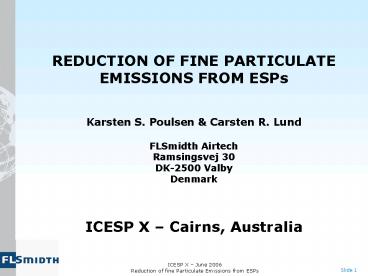REDUCTION OF FINE PARTICULATE EMISSIONS FROM ESPs - PowerPoint PPT Presentation
1 / 22
Title:
REDUCTION OF FINE PARTICULATE EMISSIONS FROM ESPs
Description:
... size distribution valuable information for ESP design and optimisation ... Proper design, optimisation and testing becomes increasingly more important ... – PowerPoint PPT presentation
Number of Views:157
Avg rating:3.0/5.0
Title: REDUCTION OF FINE PARTICULATE EMISSIONS FROM ESPs
1
REDUCTION OF FINE PARTICULATE EMISSIONS FROM
ESPs Karsten S. Poulsen Carsten R.
Lund FLSmidth Airtech Ramsingsvej 30 DK-2500
Valby Denmark ICESP X Cairns, Australia
2
- Background on fine particulate emission
- Our experiences from the path toward ideal
performance of dry ESPs including - FLSmidth Airtech Vortex Free Baffles
- on-line particle size stack-testing
- a new case story (5 in the paper)
- Conclusion on dry ESP application for fine
particulate removal
3
(No Transcript)
4
- WESP and wet scrubbers
- Barrier filters
CoromaxPulse
Indigo
Fibulax
5
- Everything works better than in real life
- Zero emissions
- Correlations are good
- Ideal conditions and full control
6
- Sneakage around the active system
- Re-entrainment
- Rapping re-entrainment
- Back corona
- Corona induced secondary rolls
- Maintenance level
but all particles can be caught
7
We must continue to optimize - discharge
electrode design - energisation - rapping
system control
- and focus on two things
- Elimination of remaining non-ideal phenomena to
approach laboratory conditions - Field tests and investigations of fine
particulate behaviour in ESPs for better
understanding and development of new full scale
features
8
9
Perforated plate blocked by dust
10
Gradual opening fully open fully
closed
11
New baffle
Full utilisation of collecting area. No sneakage
or entrainment from hopper
12
Process parameters - temperature - moisture -
flow rate ESP operation - rapping - corona
power - HV wave form
Influence on particle size ?
13
- 3 field ESP _at_ 400 mm spacing, 0.6 m/s
- TR-operation 75-55 kV / 0.06-0.3 mA/m²
- ESP inlet 60 g/Nm3, 250-300C, 30 H2O
14
On-line particle size distribution valuable
information for ESP design and optimisation
On-line low pressure impactor with dilution stages
15
Very low conc.
High conc.
Distribution during Distribution
betweenrapping rapping spikes
- Rapping loss mainly coarse particles
optimisation reqd - Fine particles in control by the elec. precip.
process - Average dust emission 1-7 mg/Nm3 low conc.
16
Low concentration of fine particles
17
- Particle size depended emission challenge
particulate filters - Electrostatic Precipitators have the potential
and ability to meet very low emission levels - Proper design, optimisation and testing becomes
increasingly more important - Eliminate non-ideal phenomena and let the
electrostatic precipitation process control the
emission a matter of ESP size - Fine particle emission can be controlled by dry
Electrostatic Precipitators
18
(No Transcript)
19
Before upgrade 50 mg/Nm3
20
(No Transcript)
21
Before upgrade 70-80 mg/Nm3
PM10lt0.33 mg/Nm3
22
Before upgrade 15-25 mg/Nm3































